#5e homebrew
Text
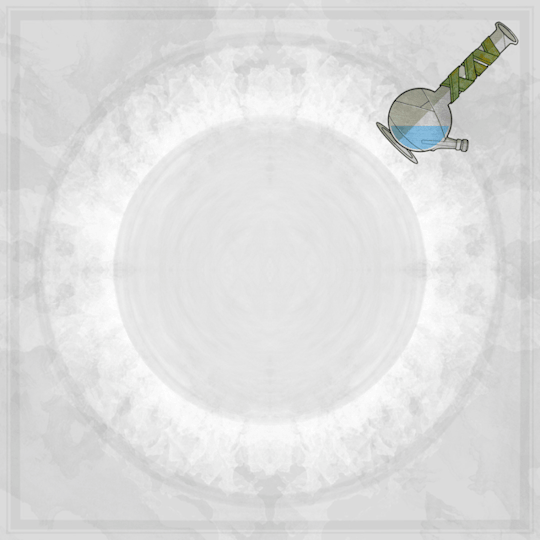
A blade of swirling smoke and reddened eyes 💨🍃
This started as a joke but I think I committed to hard - happy 420 😎
you can support me on Patreon for £1 and help me keep making art!
#Sword#art#artwork#dnd 5e homebrew#animated#animation#animators on tumblr#illustration#illustrators on tumblr#artists on tumblr#dnd item#dnd homebrew#dnd#5e homebrew#homebrew#item#magic item#pretty#digital art#digital#dungeons and dragons#fantasy#fantasy art#fantasy writing#writing#writing tumblr#dnd commission#digital commissions#commission#Flashing tw
1K notes
·
View notes
Text

Celestial 2 | Lilac Coral Fungus
The third one I drew, and I already lost track of making these simple.
Oh, and I gave it stats for D&D 5e:

B E N O T A F R A I D, or as my friends like to say,
don't worry about it
#funguary#angel#biblically accurate angel#biblically accurate fungus#celestial#art#digital art#dnd#monster design#creature design#d&d homebrew#d&d monster#5e homebrew
3K notes
·
View notes
Text
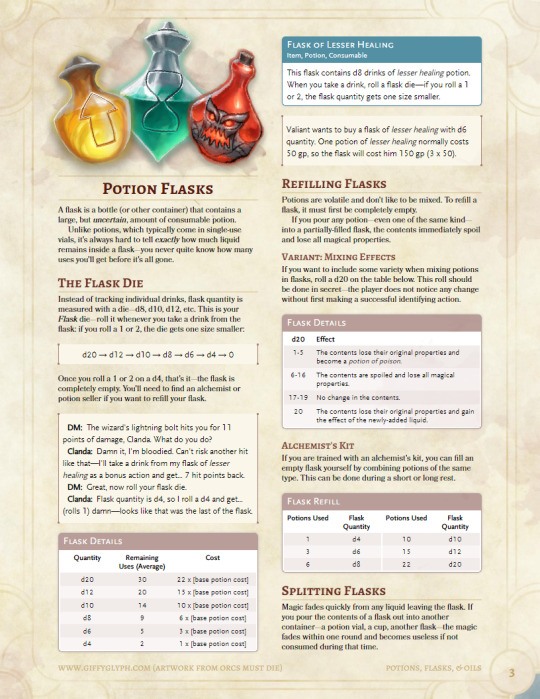
Friends, can I share one of my favourite bits of 5e homebrew?
This system (specifically the concept of a depletion die) has been a FANTASTIC addition to my campaigns, as it really breaks players out of that habit of hording consumable items and never using them for fear of needing them more at some point in the nebulous future.
You know what else this system is great for? ADVENTURING SUPPLIES. Now rather than expecting my party to go shopping and fiddle with small change and encumbrance, I just say they have a group "supply die" that's split across all their packs and baggage. How large is that supply die? Tally the group's collective strength bonus and compare it to the "average remaining uses" section of the chart. How much does it cost to resupply? There's a handy-dandy "cost" chart that you can just multiply by 10.
Rather than tracking rations, we just roll the supply die once at the end of each long rest. Whenever my party needs a random doodad that they that they could've picked up in town, they can roll the supply die and take it out of their bag, after that it's added to their permanent inventory until they lose it. Beasts of burden and carts
I've been looking for a system this elegant FOR YEARS and and finally I have it. Enjoy friends, let me know if you end up using it in your own campaigns.
590 notes
·
View notes
Text
Limit Break - An Experimental 5e OPTIONAL feature
I posted a while about an experimental feature for 5e that lets players do things not accounted for by the rules, or lets them do Cool Shit™ they wouldn't ordinarily be able to do! This is the VERY rough draft, while I work on tables of consequences for DM's that struggle with improvising or creating such elements off-hand.
Feedback is welcome, but if you're a dick about it, I'll block or ignore you as usual. I know it has been a while since I posted new original content, and this is a new feature/system to tack on to your games, so PLEASE feel free to reblog it for additional exposure so I can get more feedback. More feedback and more exposure means more original content, in the long run!

#dungeons and dragons#d&d#dnd#d&d 5e#dungeons & dragons#dungeons and dragons 5e#dnd 5e#dungeons & dragons 5e#dming#5e homebrew#homebrew#dnd homebrew#dnd 5e homebrew#ttrpg#d&d homebrew#original content#original work
539 notes
·
View notes
Text

Rise of the Undead - graves are torn open as the walking dead flood the earth…
The rumored night has come. According to the legend, the dead will begin to rise on the full moon. Graves will be torn open by emaciated fingers, tombs will be shattered by maleficent forces, and the land will be flooded with undead. That is, unless our heroes manage to stop it...
This map depicts graves being torn open as undead rise and flood the graveyard. This could serve as a "last stand" for the players, or even a survival encounter if the undead become too numerous.
You can download all 8 phases for free here.
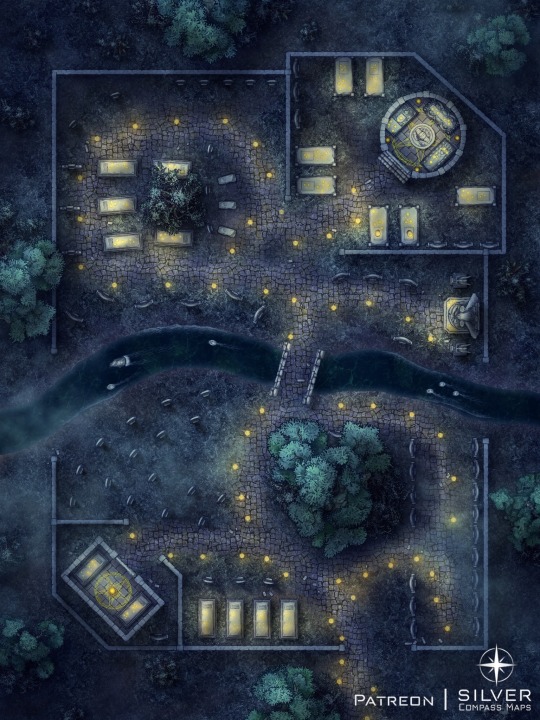
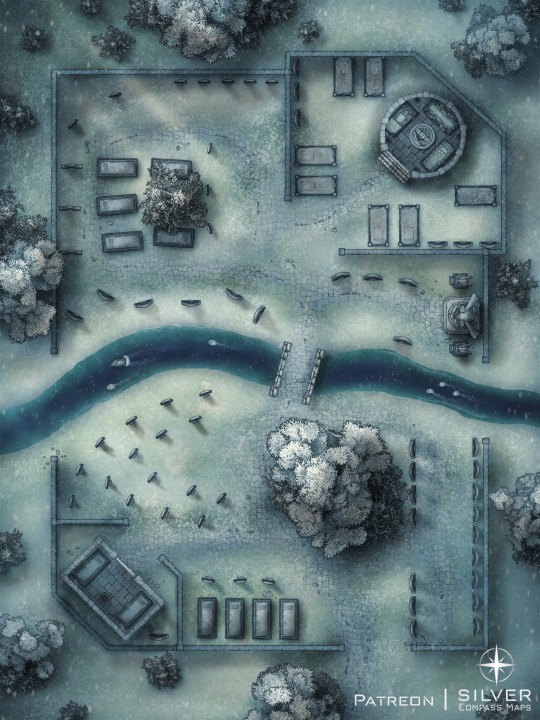
#dnd#d&d#pathfinder#tabletop#ttrpg#cartography#dndart#fantasy map#battlemaps#battle map#roll20#5e#5e homebrew#dungeons and dragons#gurps
196 notes
·
View notes
Text
A Wizard that uses a Wii Remote as their wand and can pick people up like they are a Mii in the Mii Plaza Channel.
#wizard#wizard shit#wizardposting#wizardblogging#wizardblr#dnd#D&D#dungeons and dragons#5e homebrew#Wii#Nintendo#mii#Wii remote#wands#1k
1K notes
·
View notes
Note
I run a dnd group, and I'm a big fan of crabs in particular. The last time I gave my group a giant crab encounter they loved it, and I want to do more, but I need a greater variety of crab species ideas to steal.
What types of crabs do you think are especially cool?? Or would be if they were big enough to ride like a horse? I've already done a fiddler crab and I have a horseshoe crab planned
once i homebrewed a dnd crab monster based on a massive Decorator Crab, where it allowed a massive Roper to grow on its back. it lived in a watery cave. so it looked like a regular stalagmite but was actually a crab. not only did it have a huge reach due to the Roper's tentacles, and some serious AC and resistances, but it could also move around the cave at a much faster pace than any roper alone would be capable of. it was wild and my players just ran away from it because they knew better than to attack it. anyways. use that idea. do that. and tell me about it. ropers are basically cave anemones anyways right? pom pom crab with huge fuckoff Mouth Rocks on its hands. steal this idea and tell them all whose fault it was
469 notes
·
View notes
Text
d&d 5e languages and gender
i know this is already a very nerdy blog but please indulge me a moment,,
for my homegame i've been fleshing out how different languages in the game deal with gender / pronouns based on their cultures (some of them are canon languages but some are for our setting) and it made the little nerd in me very happy so i wanted to make some headcanons for the rest of the dnd languages and share it for anyone who'd like to steal / take inspo
feel absolutely free to use these in homegames but if you use for anything streamed or for your own ttrpg/homebrew/fics then crediting/linking back is appreciated :o)
disclaimer: this blog is run by a genderqueer trans man and any queerphobic interaction will immediately be blocked
common
common started off with the standard he, she, & they pronouns but simply Loves a good loanword and so its not uncommon to hear people using pronouns from other languages in otherwise entirely common dialogue. there is some Fighting about whether this is appropriative based on the individuals culture or whether its unfair to people who only speak common to keep up with them all
dwarvish
not too much variety in what most people would consider pronouns, it tends to be more one singular neutral pronoun for someone you don't know / don't know well, and then variations that are more like honorifics than anything else. their pronoun might translate more readily to "skilled with a hammer" than anything regarding a gender
elvish
lots of pronoun options that explore different presentations of gender but they are also age/experience locked. a feminine male elf would use different pronouns as a child, teen, young adult, young adult with job, middle age, middle aged with children, etc. using pronouns from a different life experience bracket from you is incredibly frowned upon and people just dont do it
giant
there is one pronoun for giants & kin and one pronoun for not giants and the one for not giants is not derogatory at all, its just used to differentiate who is part of the family or not (individuals adopted by giants tend to use the giant pronoun)
gnomish
LOTS of variation in pronouns. gnomes love inventing new pronouns. there are general grammatical rules that they follow to Signify that its a pronoun but hearing three new pronouns a day is like. not uncommon. lots of gnomish teens go through a phase of making up at least four new pronouns they want to go by. uncommon to only go by one set. typically introduced along with your name
(more under the cut)
goblin
no gendered pronouns, all pronouns are instead structured around relations between individuals. so one person would use brother pronoun with one person, son pronoun with another, best friend pronoun to another. the family pronouns are not locked to actual family, just what the relationship is like. if you don't know someone well, its "cousin", "niece/nephew", "auntie/uncle", or "grandparent" depending on their age
halfling
pronouns are split between public and private use. in general in the community or with outsiders, there's a single pronoun that translates loosely to "friend". actual individual pronouns are only known to and used with close friends and family. there's a small handful of them and only some of them have gendered connotations
orc
there are only four categories of pronouns: masculine, feminine, both/mixed, and neither. but there's a decent amount of variations because there are varying levels of formality for each of them. there are ways to conjugate them so they're more formal and respectful, but also lots of diminutives to make them more affectionate and closely-bonded
abyssal
no use of pronouns. lots of very specific derogatory terms that are used in place of them. i shant elaborate.
celestial
lots of variations in pronouns. they are not very closely tied to gender, but are tied to very specific aesthetics. instead of having individual pronoun words, in celestial you just use root words. so one person might use the root word for things that are soft and gentle and natural for their pronoun, while another person might use the root word for things associated with dark and murky and mysterious things for theirs. tend to be tied to domains
draconic
no use of pronouns, only names and titles. if you happen to share a name with another individual who speaks draconic, you would need a unique title to go after it. the full name and full title is said at every reference of someone
deep speech
deep speech has pronouns probably but hearing them for any individual you dont share a close identity group with makes you violently nauseous and then the word immediately leaves your mind so it's just really hard to learn them
infernal
there are words for "you", "me", "us", "we", "this one", "that one", "those ones" etc but no classic pronouns as far as individual usage goes. if someone really needs to be specific they would use whatever pronoun that individual uses in their native language. tieflings have introduced a Lot of neopronouns into infernal but theyre all borrowed from other languages and then reworked into infernal grammar and tend to be localized to communities
primordial
individuals are referred to their elemental type (or "none") rather than pronouns tied to gender. so it would be more like "the windy one" or "the rocky one" than anything like he or she
sylvan
no standard gendered pronouns, it's entirely nounself. so basically infinite amount of pronouns that are easily understood by anyone familiar with that noun. so you would have things like pebble pronoun, teapot pronoun, sword pronoun, with some general affiliations with presentation but less so with gender
undercommon
pronouns are based on level of respect and not gender, but there are also pronouns specifically used for children. like craftsmen would typically all use the same pronoun unless one was incredibly successful and respected, or had a very bad reputation, etc. there are pronouns used only for royalty and pronouns used only for deities
speak with animals
when translated into common, tends to just be translated as the animal's bio sex, but it can go a little screwy when speaking about creatures who have biological sexes so outside the humanoid concept of sex and gender that even magic dont fuckin know how to translate it. kind of just makes a weird bubbly noise in its place
if you read this far thank you thank you and if you end up using these in your campaign lore or fics i would love to know :o)
151 notes
·
View notes
Text
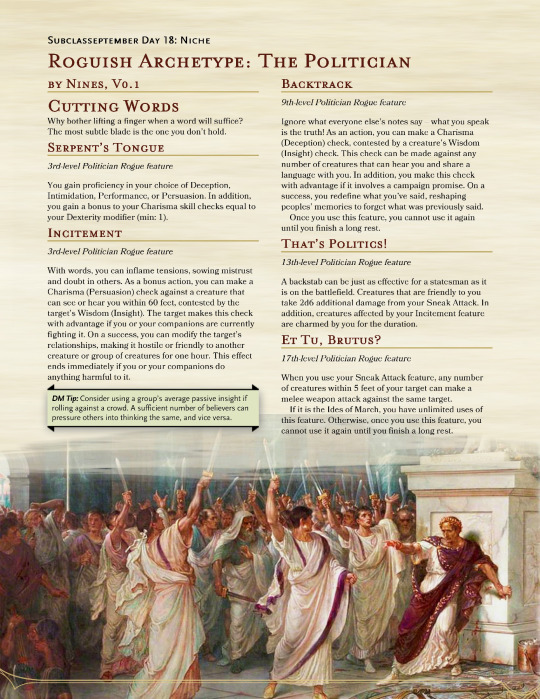
Subclasseptember Day 18: Niche
The Politician - Homebrew Rogue Subclass
Why isn't September the 7th month of the year? Whoever designed this calendar ought to be stabbed.
"Niche" as a prompt was designed to encompass weirder subclass options, ones that probably wouldn't work in every campaign. This one, for instance, could do some absurd things in a subterfuge-heavy campaign, but might not fare so well in a dungeon crawl or a wilderness expedition. But I wouldn't be surprised to see people figure out ways to get creative with the prompt.
#homebrew subclass#my homebrew#subclass homebrew#homebrew#dnd homebrew#5e homebrew#dnd 5e homebrew#subclass#subclasseptember 2023#subclasseptember#dnd subclass#dnd rogue#rogue#dnd#dnd 5e#dnd5e#d&d 5e#5e dnd#5e#dungeons and dragons#ttrpg#dnd dungeons and dragons#dungeons and dragons homebrew#dungeons and dragons 5e#d&d homebrew#d&d
263 notes
·
View notes
Text

Add some flavour to your weird and wonderful characters with this eldritch appearance table!
143 notes
·
View notes
Text
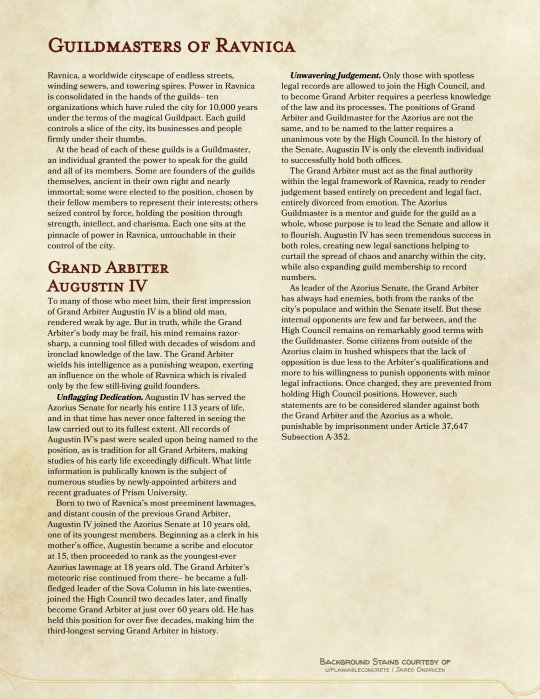


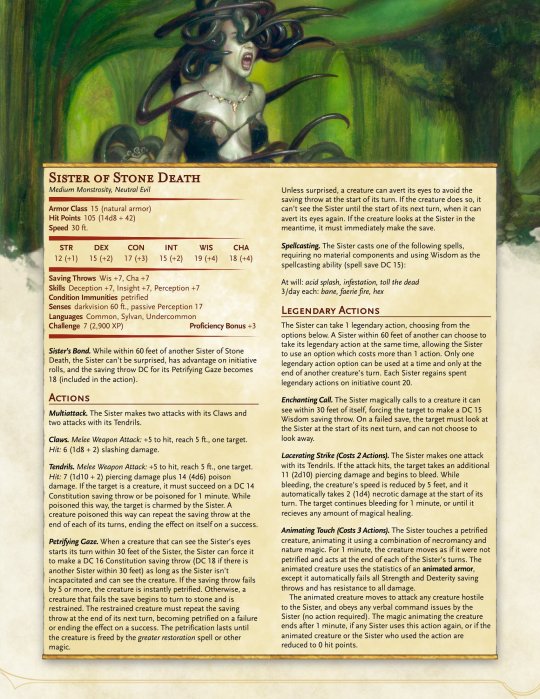
Guildmasters of Ravnica, Pt. 1
This is just a preview of five, brand-new high CR encounters for D&D 5e. Based on legendary creatures from MtG's Ravnica: City of Guilds.
If you'd like to see all five, as well as support my work and get access to other releases, you can do so over on my Patreon! Be quick though, because this release will only be public until next month.
#dnd#dnd 5e#mtg#dnd homebrew#5e homebrew#ravnica#guildmasters of ravnica#monster#cr 10#humanoid#human#cr 7#monstrosity
69 notes
·
View notes
Text

[Reddit]
Check out Tabletop Gaming Resources for more art, tips, and tools for your game!
#monster#stat card#combat sheet#stat block#combat block#dnd 5e#d&d 5e#dnd 5e homebrew#5e homebrew#CR 3#large plant#plant#tabletop rpg#rpg#tabletop gaming#pen & paper#roleplayer#roleplaying games#games#inspiration.pen & paper games#dnd#d&d#pathfinder#dungeons & dragons#dungeons and dragons#fantasy rpg#fungal bear
116 notes
·
View notes
Text

Homebrew Mechanic: Fixing D&D’s Gameplay Loop with Item Degradation
Normally I have snappy titles for these, but in this case I wanted to be super upfront with what I was getting you all into.
Some people are not going to like the idea of introducing item degradation into the game, and they’re ABSOLUTELY right to be hesitant. Just about every attempt I’ve seen (includig both RAW versions from previous editions, examples from videogames, and those I’ve put together myself in the past) have been horribly clunky exercises in beancounting that only ever existed to needlessly slow down gameplay for the sake of joyless realism.
I’ve come at it from another angle however, but to explain we’re going to need to get into some game design talk.
The basic gameplay loop of D&D is supposed to be:
Seeking adventure leads you to face challenges
Overcoming challenges leads you to rewards
Rewards Help you get stronger
Getting stronger allows you to seek tougher adventures
After a while this system starts to break down specifically with regards to gold as a method of reward. Even if you’re the smart sort of DM who flouts the rules and gives their party access to a magic item shop, there’s an increasingly limited number of things to spend gold on, leading to parties acquiring sizable hordes of riches early on in their adventuring career, completely eliminating the desire to accept quests that pay out in gold in one form or another. This is a pretty significant flaw because adventures that centre around acquisition of riches ( treasure hunts, bounty missions, busywork for rich patrons that will inevitably betray you) are foundational to storytelling within the game, especially early on in a campaign before the party has gotten emotionally invested. Most advice you can find online attempting to solve this problem tends to dissolve down to “let them pour money into a home base”, but that can only really happen once per campaign as a party is unlikely to want more than one secret clubhouse.
TLDR: What I propose is the implantation of a lightweight system that forces the party to periodically drop small amounts of wealth into maintaining their weapons/armour/foci. The players will be motivated to seek out gold in order to keep using their best stuff, giving value to treasure drops that previously lacked it. Not only does this system act as an insulation against powercreep at higher levels, it also encourages a party to engage with the world as they seek out workshops and crafters capable of repairing their gear.
The System:
Weapons, armour, shields, and caster foci (staves, holy symbols etc) can accumulate “ticks” of damage, represented by a dot or X drawn next to their item entry on the character sheet. Because you get better at handling your gear as you level up, an item that exceeds a total number of ticks equal to its bearer’s proficiency bonus breaks, and is considered unusable until it is repaired.
Weapons and Foci gain a tick of damage when you roll a natural 1 on an attack made with them, or if they are specifically targeted by an enemy’s attack.
Armour and shields gain a tick of damage when you roll a nat 1 on a saving throw or when an enemy beats your ac by 5 or more. A character equipped with both can decide which of the two items receives the tick
Creatures with the “siege” (or any “does double damage to objects” ability) deal an extra tick when attacking gear.
A character with a crafting proficiency and access to tools can repair a number of ticks of damage equal to their proficiency on a four hour work period. This rate is doubled if they have access to a properly equipped workshop. A character with access to the mending cantrip can repair ticks on any kind of item, but is limited to their proficiency bonus per work period.
Having an item repaired by an NPC crafter removes all ticks, but costs vary depending on the rarity of the item: 5g for a mundane item, 10g for a common item, 50g for uncommon, 250 for a rare, 1250 for a very rare, 6250 for a legendary. The DM decides the limit on what each crafter can repair, as it’s likely small towns have access to artisans of only common or uncommon skill, requiring the party to venture to new lands or even across planes if they wish to repair end game gear.
As you can see, degradation in this system is easy to keep track of and quite gradual, leading players into a position where they can ignore obvious damage to their kit for the sake of saving their now precious gold. It likewise encourages them to seek out NPC crafters (and potential questhooks) for skills they do not possess, and encourages the use of secondary weapons either as backups or to save the more potent items in the arsenal for a real challenge.
Consumables
Everyone knows the old joke about players hoarding consumables from the first adventure past the final bossfight, it transcends genre and platform, and speaks to a nature of loss aversion within our shared humanity. However, giving players items they’re never going to use amounts to wasted time, resources, and potential when looking at things from a game design perspective, so lets work on fixing that.
My inspiration came from witcher 3, which encourages players to make frequent use of consumables by refreshing them whenever the character had downtime. The darksouls series has a similar feature with the signature estus flask, which provides a limited number of heals before it must be refreshed at one of the game’s checkpoints. When the designers removed the risk of permanent loss and the anxiety it creatures, players were able to think tactically about the use of their consumables confident in the knowledge that any mistakes were just a resupply away from being fixed.
My proposal is that while the party is in town they can refill the majority of their consumable items for a small per item fee. Just like with gear degradation, this encourages them to seek out crafters and do quests for the hope of discounts, while at the same time encouraging them to explore new realms in the hope of discovering higher level artisans.
The price for refills is set at: 5g for common, 25g for an uncommon, 125g for a rare, 625g for a very rare, 3125g for legendary. I encourage my own players to keep a “shopping list” in their inventory with prices tabulated so they can hand out a lump sum of gold and have their kit entirely refreshed.
Characters with a relevant skill and access to their tools can refill a number of items equal to their proficiency bonus during a four hour work period. With access to a proper workshop, this rate doubles. ( At last, proficiency with brewers supplies, carpenters tools etc become useful)
I encourage you as a DM to check out this potion flasks system, which I’ve found adds a delicious factor of uncertainty back into the mix. Attached is also my super lightweight rules for tracking gear and supplies, which I absolutely refuse to shut up about.
Artist
210 notes
·
View notes
Text

Ships and Vessels
Embark on epic naval adventures with this battlemap pack featuring a diverse collection of ships and vessels! From sleek galleons to swift frigates, each map is meticulously detailed and ready for tactical encounters on the high seas.
Whether you're raiding pirate ships or defending against naval invasions, these maps provide the perfect backdrop for thrilling maritime battles.
Hey everyone, welcome to another map pack! This pack features 13 total ship maps, including sailing ships, wrecks, ghost ships, and much more.
Patrons get access to gridded/ungridded and watermark-free maps. The grid size of each map is 30x40.
You can download 4 of these ship maps for free here.



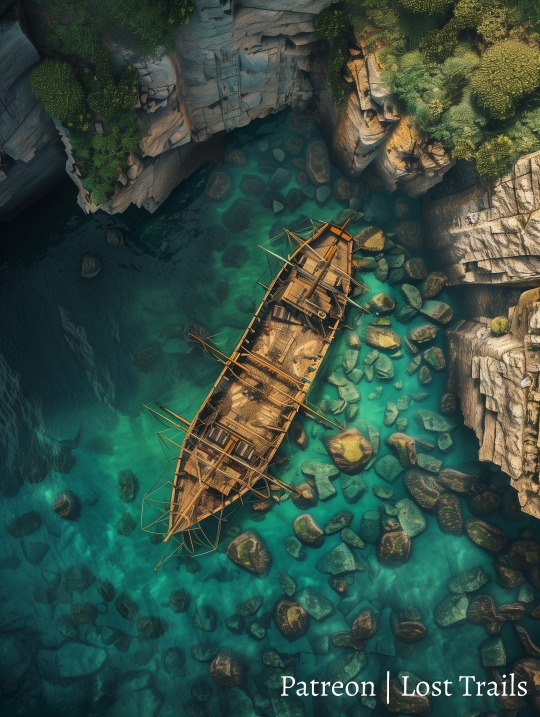
#roll20#battlemap#dnd#pathfinder#ttrpg#battlemaps#dnd maps#dnd stuff#wargaming#rpgmaps#dungeons and dragons#5e#5e homebrew#dungeon master
57 notes
·
View notes
Text
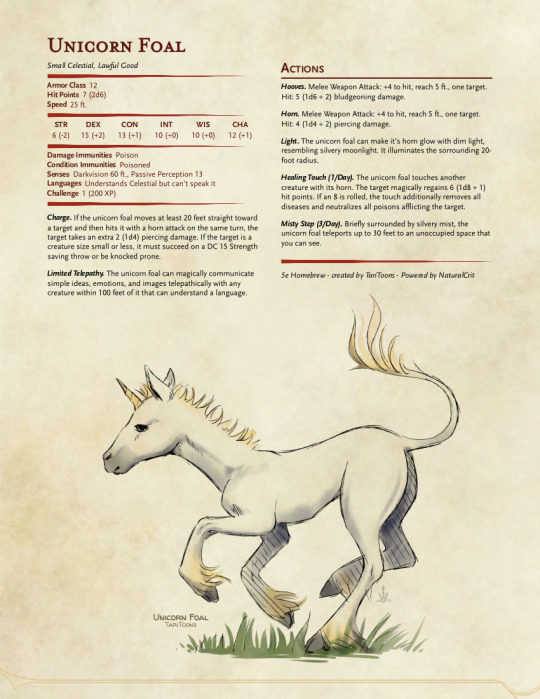
My very first homebrew! Unicorn foal stat block designed to be used as a 5e Warlock familar. PDF link here.
#dungeons and dragons#dnd#5e#5e homebrew#homebrew#stat block#unicorn#baby unicorn#unicorn foal#dnd homebrew#dnd stat block
222 notes
·
View notes
Text
Pact of the Wolf (a DND 5e Homebrew inspired by Puss in Boots: The Last Wish and Dimension 20: Neverafter)


Death is the Great Equalizer. Though they may slip through the fingers of time, fairies, fiends, and celestials alike know to fear and respect Her, and even the undead can only substract themselves from Her grasp for so long.
Thus, many mortals come to see Death as the paramount example of persistence hunting in the wild: a wolf. This aspect is apparently not distasteful to Her, as the mortals who embrace inevitabilty and forge a pact with Her manifest Her powers through the form of a mighty wolf.
These mortals, nicknamed the Sheep-Clothed, are often only asked by Death not to interfere with the natural circle of life. However, while some of the powers She grants are geared towards dealing death and destroying undead, others have the sole purpose of defying Death Herself.
We can only speculate as to why Death would arm the Sheep-Clothed with the tools to fight Her. Perhaps, like the wolves She is compared to, She enjoys the chase. Perhaps She understands that a natural part of the circle of life is mortals fiercely defending their lives. Or perhaps She wants to teach us that even with the powers of Death at their sides, everyone eventually becomes Her subject.
Oath Spells
The Wolf lets you choose from an expanded list of spells when you learn a warlock spell. The following spells are added to the warlock spell list for you.
1st level: hunter's mark, inflict wounds
3rd: gentle repose, phantasmal force
5th: life transference, phantom steed
7th: greater invisibility, mordenkainen's faithful hound
9th: enervation, reincarnate
I Just Love The Smell Of Fear
At 1st level, your patron emboldens you at the familiar sight of someone being terrified to die. When you deal damage to an enemy who is frightened of you within 15 ft using a 1st level or higher spell, you can add your proficiency bonus to the damage.
Hasta La Muerte
At 6th level, you welcome the inevitability of Death, allowing you to partially let go of your life to act one last time. While you are at 0 hitpoints, Before making a death saving throw, you can cast a spell on a creature other than you on your turn. When you do so, you suffer one failed death save.
I Welcome Your Defiance
At 10th level, the power of the Great Equalizer lets you spread Her icy embrace to all your allies, weakening its coldness. When an ally within 30 ft of you fails a death save, you can use your reaction to transfer the failed save to another willing creature within 30 ft of you.
The willing creature remains conscious if they still have remaining hitpoints, but die instantly once they receive their third failed save, no matter their remaining hitpoints. You can only transfer one failed save per reaction.
Waiting At The End Of Every Story
At 14th level, you learn to salvage the raw potential of a life meeting a brutal, early end. When you kill a spellcasting creature, you gain a temporary spell slot of half the level of the spellcaster's highest unexpended spell slot (rounded up).
If you haven't used the temporary spell slot by the end of your next turn, its unstable magical power unravels, dealing you 1d8 necrotic damage per spell level. This damage cannot be reduced in any way.
Once you use this feature, you cannot use it again until you complete a long rest.
#dnd 5e homebrew#5e homebrew#dnd 5e#dnd subclass#warlock#warlock 5e#puss in boots the last wish#dimension 20#neverafter#big bad wolf
110 notes
·
View notes